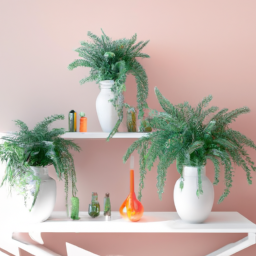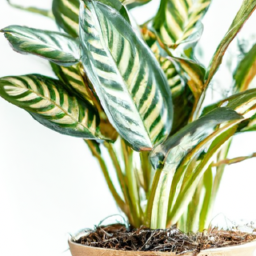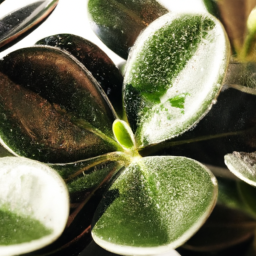
Are you looking for ways to improve the air quality in your home or office? If so, you’ve come to the right place. In this blog post, we will be discussing the top air-purifying plants for low light environments. These plants are not only beautiful additions to your space but also work wonders in filtering out harmful pollutants and toxins from the air. Whether you have a basement apartment or a windowless office, these plants thrive in low light conditions and will help create a healthier and more refreshing environment for you. So, let’s dive in and explore the best air-purifying plants for low light environments.
Benefits of Air-Purifying Plants in Low Light Environments
Indoor air pollution is a growing concern in today’s world, especially in low light environments where natural light is limited. The good news is that certain plants can help purify the air and create a healthier living space even in areas with minimal light. In this article, we will explore the benefits of air-purifying plants in low light environments and provide you with a step-by-step guide to choosing the best plants for your space.
Improved Air Quality
Air-purifying plants are nature’s air filters. They have the ability to remove harmful toxins and pollutants from the air through a process called phytoremediation. In low light environments, these plants can still effectively absorb carbon dioxide and release oxygen, improving the air quality in your home or office.
Studies have shown that air-purifying plants can remove common indoor pollutants such as formaldehyde, benzene, and trichloroethylene. These toxins are often found in household items such as furniture, carpets, and cleaning products. By introducing air-purifying plants into your low light environment, you can reduce the levels of these harmful substances and create a healthier indoor atmosphere.
Furthermore, improved air quality can have a positive impact on your overall well-being. Clean air can reduce the risk of respiratory problems, allergies, and even improve concentration and productivity. By incorporating air-purifying plants into your low light space, you can create a healthier and more pleasant environment for yourself and your loved ones.
Natural Humidifiers
Low light environments often suffer from dry air, which can lead to various health issues such as dry skin, irritated eyes, and respiratory problems. Air-purifying plants can act as natural humidifiers, increasing the moisture levels in the air and preventing these problems.
Plants release moisture through a process called transpiration. They absorb water from the soil through their roots and release it into the air through tiny openings in their leaves called stomata. This natural process helps to maintain optimal humidity levels in your low light environment, creating a more comfortable and healthy living space.
Additionally, higher humidity levels can reduce the survival rate of certain viruses and bacteria, making your indoor environment less conducive to the spread of illnesses. By incorporating air-purifying plants into your low light space, you can naturally increase humidity levels and promote better respiratory health.
Aesthetically Pleasing and Stress-Relieving
Air-purifying plants not only provide health benefits but also enhance the visual appeal of your low light environment. The presence of greenery can create a calming and stress-relieving atmosphere, helping to improve your mood and overall well-being.
Plants have been shown to reduce stress levels and increase feelings of relaxation. They can also improve cognitive function and productivity, making them a great addition to your workspace or study area in low light conditions.
Furthermore, the variety of air-purifying plants available for low light environments is vast. Whether you prefer tall, leafy plants or small, delicate ones, there is a plant to suit every aesthetic preference. You can create a mini indoor garden with a diverse range of plants, adding color, texture, and life to your low light space.
In conclusion, air-purifying plants offer numerous benefits in low light environments. They improve air quality, act as natural humidifiers, and provide aesthetic appeal while reducing stress levels. By incorporating these plants into your low light space, you can create a healthier, more comfortable, and visually appealing environment. So why wait? Start exploring the world of air-purifying plants and transform your low light environment today!
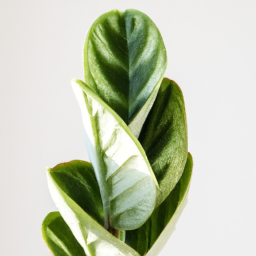
Choosing the Right Air-Purifying Plants for Low Light Spaces
When it comes to creating a healthy and vibrant indoor environment, air quality plays a crucial role. Poor air quality can lead to various health issues, including allergies, respiratory problems, and even reduced productivity. One effective way to improve air quality indoors is by incorporating air-purifying plants into your space. However, not all plants thrive in low light environments, so it’s essential to choose the right ones. In this guide, we will explore the top air-purifying plants that are well-suited for low light spaces.
Understanding Low Light Environments
Before diving into the specific plants, it’s important to understand what constitutes a low light environment. Low light spaces are areas in your home or office that receive minimal natural sunlight, such as rooms with few or small windows, basements, or areas far from windows. These areas typically have low levels of indirect or filtered light, which can make it challenging for plants to thrive.
It’s crucial to consider the light requirements of plants when selecting air-purifying varieties for low light environments. While most plants require a good amount of sunlight to photosynthesize and grow, there are several species that have adapted to survive in low light conditions. These plants are not only capable of thriving with minimal light but also excel in purifying the air.
Top Air-Purifying Plants for Low Light Environments
1. Snake Plant (Sansevieria Trifasciata)
The Snake Plant, also known as Mother-in-Law’s Tongue, is a popular choice for low light environments. It is highly adaptable and can tolerate a wide range of light conditions, including low light. This plant is known for its ability to filter out toxins like formaldehyde, benzene, and xylene from the air. Snake plants are also low-maintenance, making them ideal for busy individuals or those without a green thumb.
2. Peace Lily (Spathiphyllum)
The Peace Lily is another excellent choice for low light spaces. It features beautiful white flowers and glossy green leaves, adding a touch of elegance to any room. This plant is known for its ability to remove common indoor air pollutants, including formaldehyde, benzene, and trichloroethylene. The Peace Lily prefers medium to low light conditions, making it an ideal choice for areas with limited natural sunlight.
3. ZZ Plant (Zamioculcas Zamiifolia)
The ZZ Plant is a visually appealing plant that can thrive in low light environments. Its glossy, dark green leaves add a touch of lushness to any space. This plant is highly tolerant of neglect and can go for long periods without water. The ZZ Plant is known for its ability to remove toxins like xylene, toluene, and benzene from the air, making it an excellent choice for improving indoor air quality.
Caring for Air-Purifying Plants in Low Light Environments
While these air-purifying plants are well-suited for low light environments, it’s important to provide them with the care they need to thrive. Here are some essential care tips:
1. Watering: Most air-purifying plants prefer slightly moist soil. Avoid overwatering, as it can lead to root rot. Water the plants when the top inch of soil feels dry to the touch.
2. Fertilizing: Use a balanced, water-soluble fertilizer once a month during the growing season to provide essential nutrients to the plants.
3. Pruning: Regularly remove any dead or yellowing leaves to maintain the plant’s health and appearance.
4. Cleaning: Wipe the leaves of your air-purifying plants with a damp cloth to remove dust and keep them free from pests.
5. Placement: While these plants can tolerate low light, try to place them near windows or areas with indirect light to provide some natural sunlight.
By following these care tips, you can ensure that your air-purifying plants thrive and continue to purify the air in your low light environment.
In conclusion, selecting the right air-purifying plants for low light environments is essential for improving indoor air quality. Snake plants, Peace Lilies, and ZZ Plants are just a few examples of plants that can thrive in low light conditions while effectively purifying the air. By understanding the light requirements of these plants and providing proper care, you can create a healthier and more enjoyable indoor environment.
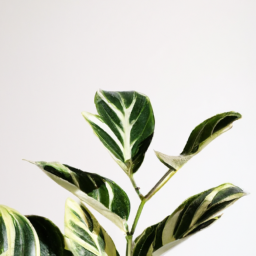
Maintenance Tips for Air-Purifying Plants in Low Light Environments
Introduction
Air-purifying plants are not only aesthetically pleasing but also act as natural filters, improving the air quality in our homes and offices. However, maintaining these plants in low light environments can be a bit challenging. In this guide, we will provide you with step-by-step maintenance tips to ensure the health and longevity of your air-purifying plants in low light conditions. Let’s dive in!
1. Choosing the Right Plants
When selecting air-purifying plants for low light environments, it is crucial to choose species that are well-suited for such conditions. Here are some top choices:
Snake Plant (Sansevieria trifasciata)
The Snake Plant is a resilient plant that thrives in low light conditions, making it an excellent choice for air purification in darker spaces. It has long, upright leaves with variegated patterns, adding a touch of elegance to any room. Snake Plants are known for their ability to convert carbon dioxide into oxygen during the night, making them ideal for bedrooms.
ZZ Plant (Zamioculcas zamiifolia)
The ZZ Plant is another low light champion that can tolerate neglect and low light conditions. Its glossy, dark green leaves make it a visually appealing addition to any space. ZZ Plants are excellent at removing toxins like xylene and toluene from the air, making them a great choice for offices or rooms with limited natural light.
Peace Lily (Spathiphyllum)
The Peace Lily is a popular choice for low light environments due to its ability to thrive in shade. It features elegant white flowers that add a touch of beauty to any room. Peace Lilies are effective at removing airborne toxins like benzene, formaldehyde, and trichloroethylene. However, it’s important to note that Peace Lilies are toxic to pets, so keep them out of reach of curious furry friends.
2. Proper Watering Techniques
Watering is a critical aspect of maintaining air-purifying plants in low light environments. Here are some essential tips to keep in mind:
Check Moisture Levels
Before watering, always check the moisture levels of the soil. Stick your finger about an inch deep into the soil – if it feels dry, it’s time to water. If it’s still moist, hold off on watering for a few more days.
Watering Frequency
In low light environments, plants tend to require less water due to slower growth and reduced evaporation. It is crucial not to overwater your air-purifying plants as it can lead to root rot. Water your plants thoroughly, allowing the excess water to drain out of the pot. Empty the saucer beneath the pot to avoid water accumulation.
Use Room Temperature Water
Avoid using cold water straight from the tap, as it can shock the plant’s roots. Instead, let the water sit overnight or use room temperature water to prevent temperature stress on the plant.
3. Adequate Lighting
While air-purifying plants can tolerate low light conditions, they still require some degree of light to thrive. Here’s how you can provide adequate lighting for your plants:
Indirect Sunlight
Place your air-purifying plants near windows that receive indirect sunlight. Avoid exposing them to direct sunlight, especially during the hottest hours of the day, as it can scorch the leaves.
Artificial Lighting
If your low light environment doesn’t receive sufficient natural light, consider using artificial lighting sources. LED grow lights or fluorescent lights can provide the necessary light spectrum for your plants’ growth. Position the lights about 6-12 inches above the plants and keep them on for around 12-16 hours a day.
Rotate the Plants
To ensure even growth and prevent your plants from leaning towards the light source, rotate them every few weeks. This will help all sides of the plant receive equal light exposure.
4. Regular Cleaning
Dust and debris can accumulate on the leaves of air-purifying plants, hindering their ability to photosynthesize and purify the air. Regular cleaning is essential to maintain their health:
Gently Wipe the Leaves
Using a soft, damp cloth or sponge, gently wipe the leaves to remove dust and grime. This will not only improve the plant’s appearance but also allow it to breathe better.
Avoid Leaf Shine Products
While it may be tempting to use leaf shine products to make the leaves appear glossy, it is best to avoid them. These products can clog the plant’s pores and interfere with its natural respiration process.
Trim Yellow or Browning Leaves
If you notice any yellow or browning leaves, trim them off using clean pruning shears. This will redirect the plant’s energy towards healthy growth.
Conclusion
Maintaining air-purifying plants in low light environments requires careful consideration of plant selection, proper watering techniques, adequate lighting, and regular cleaning. By following these step-by-step maintenance tips, you can ensure that your air-purifying plants thrive and continue to improve the air quality in your surroundings. So go ahead, bring some greenery into your low light spaces and enjoy the benefits of cleaner air!
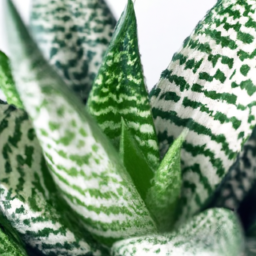
Top 5 Air-Purifying Plants for Low Light Spaces
Having clean and fresh air is essential for our overall well-being, and one way to achieve this is by incorporating air-purifying plants into our living spaces. However, not all plants thrive in low light environments, making it challenging to find suitable options. In this article, we will explore the top 5 air-purifying plants that can thrive in low light spaces, allowing you to breathe easier and enjoy the benefits of indoor gardening.
1. Snake Plant (Sansevieria trifasciata)
The Snake Plant, also known as Mother-in-Law’s Tongue, is a popular choice for low light environments due to its ability to thrive in various lighting conditions. It is an excellent air purifier, removing toxins such as formaldehyde and benzene from the air. This plant has long, upright leaves that are dark green with yellow edges, adding a touch of elegance to any room.
To care for a Snake Plant, place it in a spot with indirect sunlight or even artificial light. It is a low-maintenance plant that can tolerate infrequent watering, making it perfect for those who tend to forget about their plants. Be cautious not to overwater, as this can lead to root rot.
Another benefit of the Snake Plant is its ability to release oxygen at night, making it an ideal plant for bedrooms. It can improve the air quality while you sleep, promoting a more restful night’s sleep.
2. ZZ Plant (Zamioculcas zamiifolia)
The ZZ Plant is a hardy and resilient plant that can thrive in low light conditions, making it an excellent choice for offices or rooms with limited natural light. Its glossy, dark green leaves add a touch of beauty to any space while effectively purifying the air.
This plant is known for its ability to remove toxins such as xylene and toluene from the air. It is also a great plant for beginners, as it can tolerate neglect and does not require frequent watering. The ZZ Plant stores water in its rhizomes, allowing it to survive in drought-like conditions.
Place the ZZ Plant in a location with indirect or low light, as direct sunlight can scorch its leaves. Water the plant when the top inch of soil feels dry, and be cautious not to overwater, as this can lead to root rot.
3. Peace Lily (Spathiphyllum)
The Peace Lily is a beautiful flowering plant that can thrive in low light environments. It has dark green leaves and elegant white flowers, adding a touch of tranquility to any space. Not only is it visually appealing, but it also effectively removes toxins such as formaldehyde, benzene, and trichloroethylene from the air.
Caring for a Peace Lily is relatively easy. Place it in a spot with indirect or low light, as direct sunlight can scorch its leaves. Keep the soil slightly moist, but be cautious not to overwater. The Peace Lily will droop when it needs water, making it a good indicator for watering.
One important thing to note is that the Peace Lily is toxic to pets if ingested. Therefore, it is essential to keep it out of reach of curious cats and dogs.
4. Cast Iron Plant (Aspidistra elatior)
The Cast Iron Plant is a hardy and resilient plant that can tolerate low light conditions and neglect. It has dark green, leathery leaves that can add a touch of elegance to any room. This plant is an excellent air purifier, removing toxins such as formaldehyde, benzene, and carbon monoxide from the air.
Place the Cast Iron Plant in a spot with low to indirect light, as direct sunlight can scorch its leaves. Water the plant when the top inch of soil feels dry, but be cautious not to overwater, as it can lead to root rot. This plant can survive in drought-like conditions, making it perfect for those who tend to forget about watering their plants.
The Cast Iron Plant is also known for its ability to withstand temperature fluctuations, making it suitable for spaces with varying temperatures.
5. Chinese Evergreen (Aglaonema)
The Chinese Evergreen is a popular choice for low light environments due to its ability to thrive in shaded areas. It has attractive, variegated leaves that come in various shades of green, silver, and pink. This plant effectively removes toxins such as formaldehyde and benzene from the air, improving the overall air quality.
To care for a Chinese Evergreen, place it in a spot with low to indirect light. Avoid direct sunlight, as it can scorch the leaves. Water the plant when the top inch of soil feels dry, and be cautious not to overwater, as it can lead to root rot.
This plant is relatively low-maintenance and can tolerate a range of temperatures, making it suitable for various indoor environments.
By incorporating these top 5 air-purifying plants into your low light spaces, you can enjoy cleaner and fresher air while adding a touch of nature to your surroundings. Remember to consider each plant’s specific care requirements to ensure their optimal growth and longevity. Happy indoor gardening!
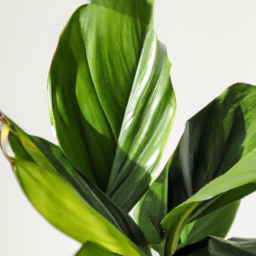
Creating a Healthy Indoor Environment with Air-Purifying Plants in Low Light Areas
Indoor air pollution is a growing concern, as we spend most of our time indoors. To combat this issue, incorporating air-purifying plants into your indoor space can help improve air quality and create a healthier environment. However, low light areas can pose a challenge when it comes to finding suitable plants that thrive in such conditions. In this guide, we will explore the top air-purifying plants that are well-suited for low light environments.
Understanding the Importance of Indoor Air Quality
Before delving into the specific plants, it is crucial to understand the significance of indoor air quality. Poor air quality can lead to various health issues such as allergies, respiratory problems, and even long-term effects on overall well-being. Indoor air can be contaminated with pollutants like dust, chemicals, and volatile organic compounds (VOCs) emitted by household products and materials. Air-purifying plants can effectively filter out these pollutants, providing cleaner and fresher air to breathe.
When it comes to low light areas, it is essential to choose plants that can thrive with minimal sunlight. While most plants require adequate light for photosynthesis, some have adapted to survive in low light conditions and can still perform their air-purifying functions effectively.
The Top Air-Purifying Plants for Low Light Environments
1. Snake Plant (Sansevieria trifasciata):
The Snake Plant, also known as Mother-in-Law’s Tongue, is a popular choice for low light environments. It is a hardy plant that can tolerate a wide range of light conditions, including low light. The Snake Plant is known for its ability to filter out toxins such as formaldehyde, benzene, and xylene. It releases oxygen at night, making it an ideal plant for bedrooms to enhance air quality while you sleep.
2. Peace Lily (Spathiphyllum):
The Peace Lily is another excellent option for low light areas. It is a beautiful plant with dark green leaves and elegant white flowers. The Peace Lily is known for its ability to remove common indoor pollutants such as formaldehyde, benzene, and trichloroethylene. It also helps to increase humidity levels, making it beneficial for dry indoor environments.
3. Boston Fern (Nephrolepis exaltata):
The Boston Fern is a classic choice for indoor spaces due to its lush foliage and air-purifying properties. While it prefers bright, indirect light, it can still thrive in low light conditions. The Boston Fern is highly effective in removing formaldehyde, xylene, and toluene from the air. Additionally, it can help to naturally humidify the surrounding air, reducing the risk of dryness and respiratory discomfort.
Tips for Caring for Air-Purifying Plants in Low Light Environments
1. Placement:
When placing air-purifying plants in low light areas, it is crucial to find the right spot where they can receive the maximum amount of available light. While they can tolerate low light conditions, they still require some indirect sunlight to thrive. Placing them near windows or artificial light sources can help provide the necessary light for their growth.
2. Watering:
Proper watering is essential for the health of air-purifying plants. In low light areas, the soil tends to dry out more slowly, so it is crucial to avoid overwatering. Check the moisture level of the soil regularly and water only when the top inch feels dry. Ensure good drainage to prevent waterlogging, as it can lead to root rot.
3. Avoid Overfertilization:
While fertilization is necessary for plant growth, overfertilizing can be detrimental, especially in low light conditions. Excessive nutrients can build up in the soil and cause damage to the plants. Use a balanced, slow-release fertilizer and follow the recommended dosage to avoid overfertilization.
4. Regular Cleaning:
Dust and debris can accumulate on the leaves of air-purifying plants, hindering their ability to photosynthesize effectively. Regularly wipe the leaves with a damp cloth to remove dust and keep them clean. This will ensure optimal air-purifying performance and maintain the overall health of the plants.
By incorporating these top air-purifying plants into your low light indoor spaces and following the care tips mentioned above, you can create a healthier environment with improved indoor air quality. These plants not only enhance the aesthetics of your space but also provide numerous health benefits. Breathe in cleaner air and enjoy the beauty of nature within the comfort of your home or office!
Recap of this article
If you have a low light environment in your home or office, you may think that having air-purifying plants is not an option. However, there are several plants that thrive in low light conditions while also improving the air quality. In this blog post, we will explore some of the top air-purifying plants that are perfect for low light environments.
One of the best air-purifying plants for low light areas is the snake plant. Also known as Sansevieria, this plant is incredibly hardy and can survive in almost any lighting condition. It is known for its ability to remove toxins like formaldehyde and benzene from the air, making it a great choice for improving indoor air quality.
Another great option is the peace lily, a beautiful plant that can thrive in low light conditions. Peace lilies are known for their ability to remove harmful chemicals like formaldehyde, benzene, and trichloroethylene from the air. They also add a touch of elegance to any space with their white flowers.
Lastly, the pothos plant is an excellent choice for low light environments. This plant is incredibly easy to care for and can tolerate a wide range of lighting conditions. Pothos plants are known for their ability to remove toxins like formaldehyde and carbon monoxide from the air, making them a perfect addition to any low light space.
In conclusion, having a low light environment doesn’t mean you have to compromise on air quality. By choosing air-purifying plants like snake plants, peace lilies, and pothos plants, you can enjoy cleaner and fresher air even in areas with limited natural light.
Top FAQs:
Q1: What are air-purifying plants?
A1: Air-purifying plants are indoor plants that have the ability to remove toxins and pollutants from the air, improving the air quality in your home or office.
Q2: Why is it important to have air-purifying plants in low light environments?
A2: Low light environments typically have limited access to natural sunlight, which can make it challenging for plants to thrive. Having air-purifying plants in these environments is important as they can still effectively filter the air and provide the benefits of improved air quality.
Q3: Which air-purifying plants are suitable for low light environments?
A3: Some air-purifying plants that thrive in low light environments include the snake plant (Sansevieria), pothos (Epipremnum aureum), peace lily (Spathiphyllum), ZZ plant (Zamioculcas zamiifolia), and Chinese evergreen (Aglaonema).
Q4: How do air-purifying plants improve indoor air quality?
A4: Air-purifying plants improve indoor air quality by absorbing harmful gases and toxins through their leaves and roots. They can filter out pollutants such as formaldehyde, benzene, and trichloroethylene, which are commonly found in indoor environments.
Q5: Do air-purifying plants require special care in low light environments?
A5: While air-purifying plants can tolerate low light conditions, they still require some care. It’s important to ensure they receive indirect or filtered light, avoid overwatering, and provide occasional fertilization to support their growth.
Q6: Can air-purifying plants be placed in rooms without windows?
A6: Yes, air-purifying plants can be placed in rooms without windows, as long as there is some source of light available, such as artificial lighting. However, it’s important to note that plants still benefit from natural light, so occasional exposure to sunlight or daylight from nearby rooms is beneficial.
Q7: How many air-purifying plants should I have in a low light environment?
A7: The number of air-purifying plants you should have in a low light environment depends on the size of the space and your personal preference. As a general guideline, having at least one medium-sized plant for every 100 square feet of space is recommended.
Q8: Can air-purifying plants help reduce allergies and respiratory issues?
A8: Yes, air-purifying plants can help reduce allergies and respiratory issues by removing airborne pollutants and increasing humidity levels. However, it’s important to note that plants alone may not completely alleviate these conditions, and consulting with a healthcare professional is advisable for specific concerns.
Q9: Are air-purifying plants safe for pets?
A9: While many air-purifying plants are safe for pets, some can be toxic if ingested. It’s important to research and choose pet-friendly air-purifying plants, such as the spider plant (Chlorophytum comosum) or Boston fern (Nephrolepis exaltata). Placing plants out of reach or using protective barriers can also help ensure pet safety.
Q10: Where can I purchase air-purifying plants for low light environments?
A10: Air-purifying plants for low light environments can be purchased at local plant nurseries, home improvement stores, or online plant retailers. Additionally, you can also consider propagating plants from cuttings or seeking recommendations from fellow plant enthusiasts or gardening communities.
Dr. Olivia Green is a botanist with over two decades of experience in indoor plant cultivation. She holds a Ph.D. in Plant Biology and has dedicated her career to researching plant behavior in controlled environments. Dr. Green is passionate about helping plant enthusiasts master the art of indoor gardening through her extensive knowledge and practical insights.

